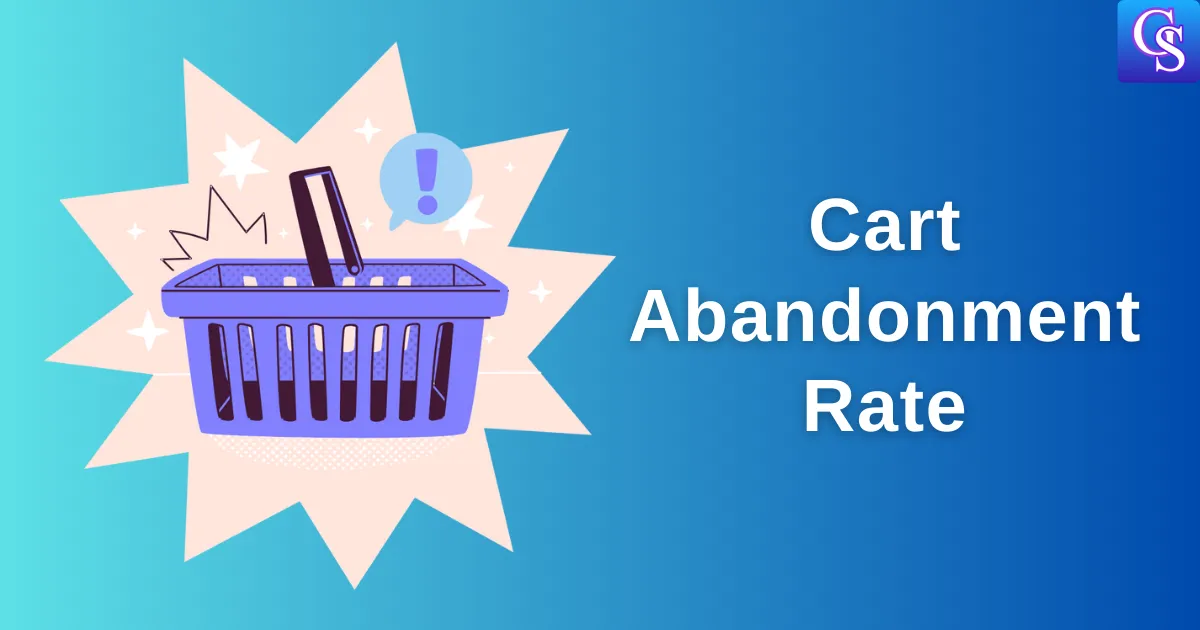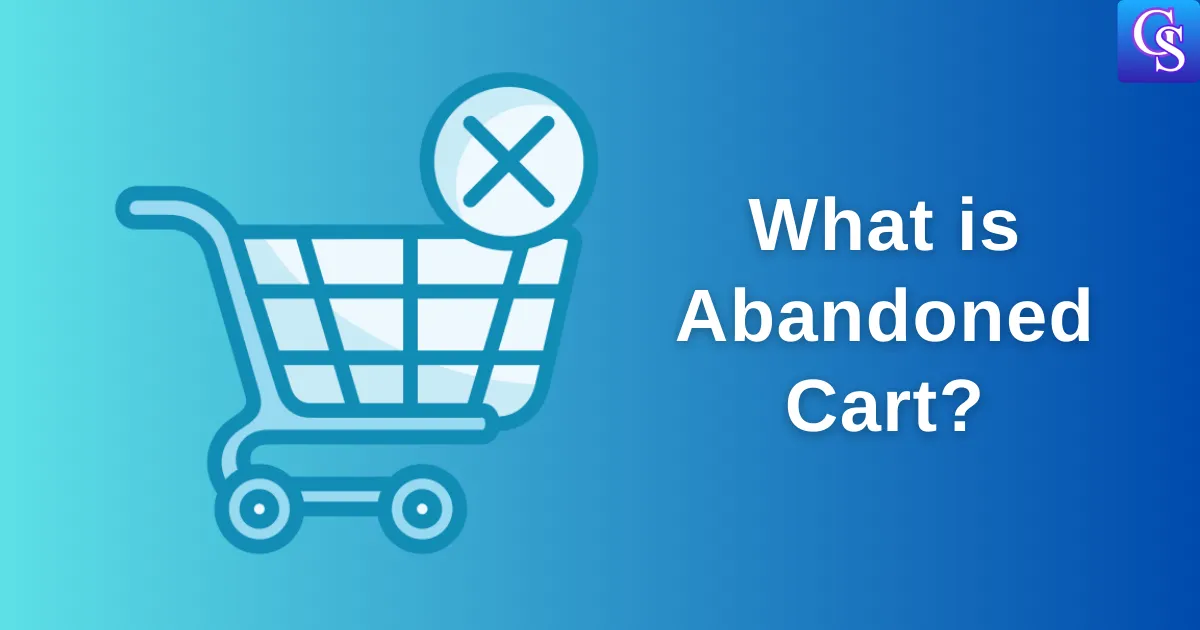Table of Contents
ToggleWhat is the Cart Abandonment Rate?
Cart abandonment rate is the percentage of online shoppers who add items to their virtual shopping cart but then abandon it before completing the purchase.
It’s like a ratio that shows how many people leave their carts compared to the number who start the checkout process. This helps us understand why shoppers leave without buying and where we can improve their online shopping experience.
For example, if many people abandon their carts, it might indicate problems with the website, unexpected costs, a complicated checkout process, or a lack of trust. By looking into this rate, businesses can find and fix these problems to sell more.
Average Cart Abandonment Rate
The average cart abandonment rate across e-commerce websites is about 70%. This means that roughly 7 out of 10 customers who add items to their cart leave without buying anything.
While this may seem like a lot, it’s important to remember that some people might just be browsing, comparing prices, or saving items for later.
However, a significant portion of cart abandonment is preventable.
By understanding the reasons behind it and using effective strategies, businesses can significantly reduce this rate and recover lost sales, which translates to a potential of $260 billion a year.
Shopping Cart Abandonment Rate Formula:
Calculating the cart abandonment rate is a simple process. Here’s the formula:
Cart Abandonment Rate = (1 - (Number of Completed Purchases / Number of Initiated Sales)) * 100
For example, if an e-commerce store had 100 initiated sales (add to cart) and 30 completed purchases, the cart abandonment rate would be:
(1 – (30 / 100)) * 100 = 70%
This means that 70% of the customers who added items to their cart abandoned it before completing the purchase.
Cart Abandonment Rate by Industry
Cart abandonment rates are different across different industries and regions. Here’s a breakdown:
- Fashion: The fashion industry has a high cart abandonment rate, typically around 73%. This can be because shoppers are unsure about sizes, there are many choices, and people tend to “window shop” more in this industry.
- Electronics: The electronics industry also has a high abandonment rate, with some studies reporting it as high as 88.6%. This could be because electronics are expensive, people are sensitive to price changes, and they often compare prices at different stores.
- Travel: The travel industry has one of the highest cart abandonment rates, around 80%. This is often because booking travel can be complicated, prices change a lot, and people need to do a lot of research and planning.
- Regional Differences: Globally, the Caribbean has the highest cart abandonment rate (92.2%), while the Asia & Pacific region has the lowest (76.3%). This highlights the importance of considering regional factors when evaluating and addressing cart abandonment.
Besides industry variations, the device used for online shopping also plays a significant role in cart abandonment rates.
Cart Abandonment Rate by Device
The device a customer uses for online shopping can affect how likely they are to abandon their cart. Here’s a comparison:
- Desktop: Cart abandonment rates on desktops are generally lower than other devices, averaging around 70%. This could be because desktops have larger screens, making browsing and checkout more comfortable.
- Mobile: Mobile devices have the highest cart abandonment rate, around 85.65%. This can be because of smaller screens, slower loading times, and a checkout process that’s not as smooth on mobile. It’s concerning that despite mobile having the highest cart abandonment rate, most brands don’t prioritize the mobile checkout experience.
- Tablet: Tablets have a cart abandonment rate of 70.01%.
- Mobile Operating Systems: When looking at mobile devices, iOS has the highest cart abandonment rate (82%), followed by Android (81%). This suggests that optimizing the checkout experience for these specific operating systems could be beneficial.
Top Reasons for Increase in Cart Abandonment Rate
| Reason | Description |
|---|---|
| Unexpected Costs | High shipping costs, taxes, or other fees added at the checkout stage can discourage online shoppers. |
| Complicated Checkout Process | A long or complex checkout process with many steps and forms can frustrate customers. |
| Lack of Trust | Concerns about website security, payment security, or unclear return policies can make customers hesitant. |
| Slow Delivery | Long delivery times can be a problem, especially when customers need their purchase quickly. |
| Website Issues | Website errors, crashes, or slow loading times can disrupt the shopping experience. |
| Mandatory Account Creation | Requiring customers to create an account before checkout can be an obstacle. |
| Insufficient Payment Options | If customers can’t use their preferred payment method, they might not complete their purchase. |
Strategies for Reducing Cart Abandonment Rate
There are several ways to reduce cart abandonment:
- Optimize Checkout Process: Make the checkout process simple by reducing the number of steps, allowing guest checkout, and making it easier to fill out forms. For example, reduce the number of form fields, offer express checkout options, and use clear progress indicators.
- Offer Multiple Payment Options: Give customers different ways to pay, like credit cards, digital wallets, and other popular methods.
- Transparent Pricing: Show all costs upfront, including shipping, taxes, and other fees, so customers aren’t surprised at checkout.
- Build Trust: Display security badges, customer testimonials, and clear return policies to build trust and address security concerns.
- Improve Website Performance: Make sure the website loads quickly, is easy to use, and provides a smooth shopping experience on all devices.
- Offer Incentives: Encourage customers to complete their purchase by offering incentives like free shipping, discounts, or exclusive deals.
- Retargeting Campaigns: Use retargeting campaigns to remind customers about the items they left in their cart and encourage them to return to your website.
- Abandoned Cart Emails: Send personalized emails to customers who abandoned their carts, reminding them of the items they left and offering help or incentives to complete the purchase.
- Try Automation: Using automation can help guide customers through the checkout process, offer personalized recommendations, and streamline the overall experience, leading to a significant reduction in cart abandonment rates. B2C businesses that use automated workflows to resolve cart abandonment have seen a 50% increase in conversion rate.
- Provide clear and concise product information: Make sure product descriptions are detailed, accurate, and include high-quality images.
- Offer live chat support: Give customers real-time help if they have questions or problems during checkout.
- Use exit-intent popups: Show targeted popups to customers who are about to leave the website, offering incentives or reminding them of their cart.
- Optimize for mobile devices: Ensure the website and checkout process are fully optimized for mobile users.
- Personalize the shopping experience: Use personalization techniques to tailor product recommendations, offers, and communication to individual customers.
Cart Abandonment Rate Statistics
While the average cart abandonment rate is around 70%, it’s helpful to know industry trends and statistics to see how you’re doing and where you can improve. Here are some key statistics:
- Cart abandonment rates can change throughout the year, with higher rates during holidays and sales events.
- Mobile devices consistently have the highest cart abandonment rates compared to desktops and tablets.
- Emails sent to recover abandoned carts have an average open rate of 39.07% and a click-through rate of 23.33%.
Conclusion
Cart abandonment is a common problem in e-commerce, but it’s not impossible to overcome. By understanding the reasons behind it and using effective strategies, businesses can significantly reduce their cart abandonment rate and recover lost revenue.
It’s important to remember that the entire user experience, not just the checkout page, influences cart abandonment. Therefore, businesses should focus on optimizing the entire online shopping journey.
Continuous monitoring of industry trends, customer behaviour, and website performance is crucial for improving the online shopping experience and maximizing conversions.
By taking proactive steps to address cart abandonment, businesses can significantly improve their bottom line. If you want help with reducing your cart abandonment and increasing your sales, try our e-commerce services and contact us




